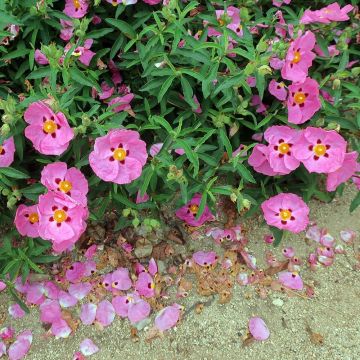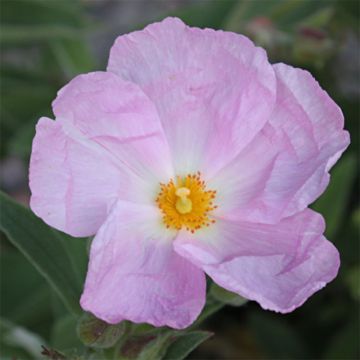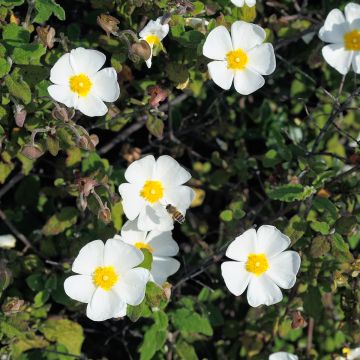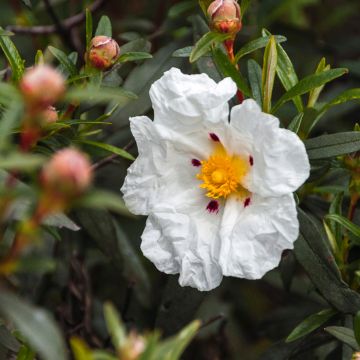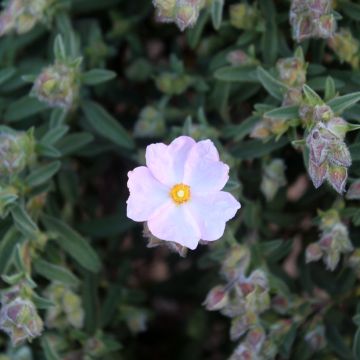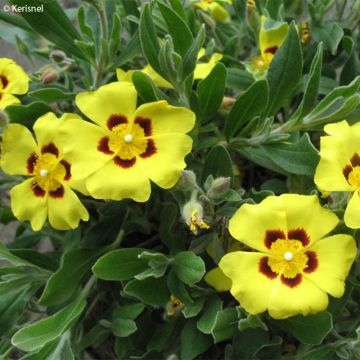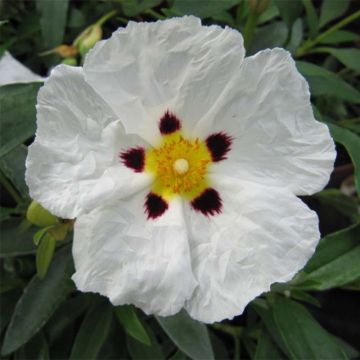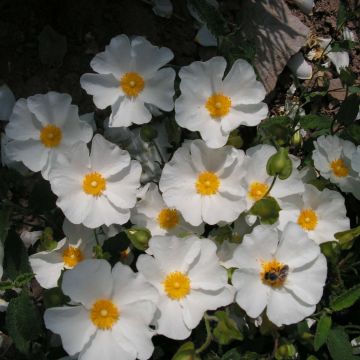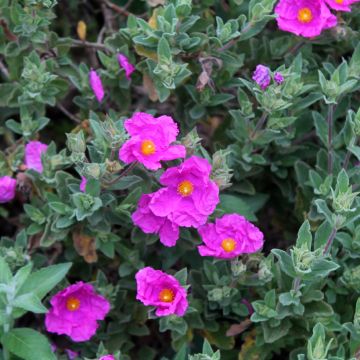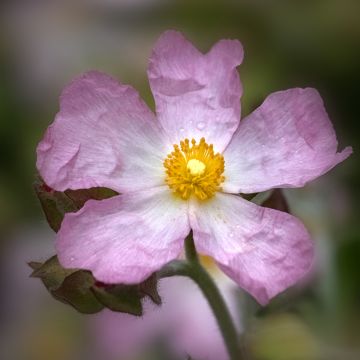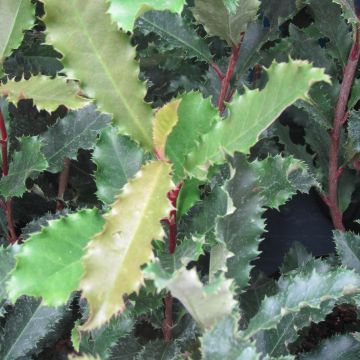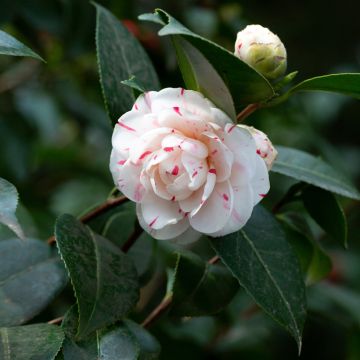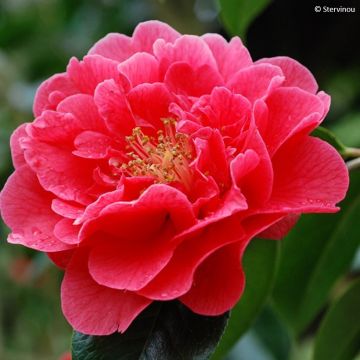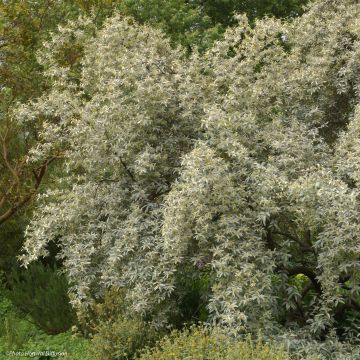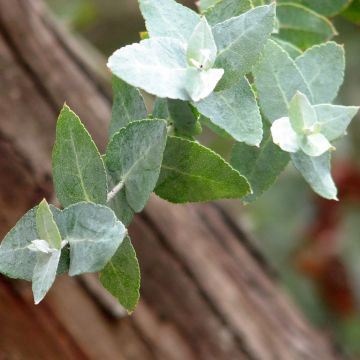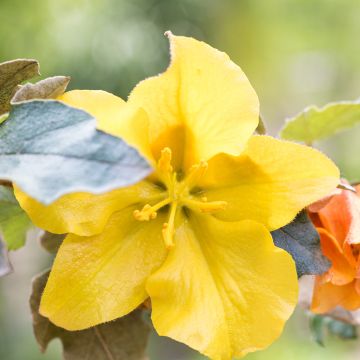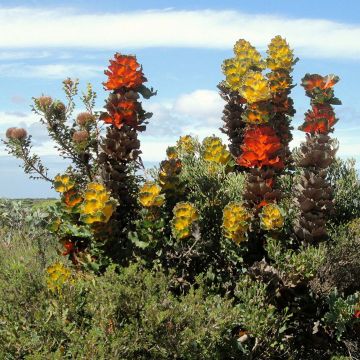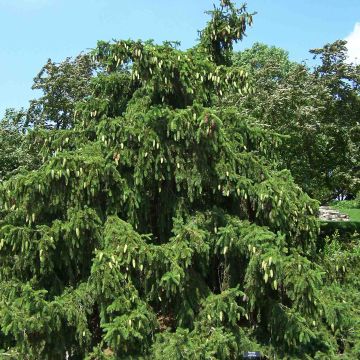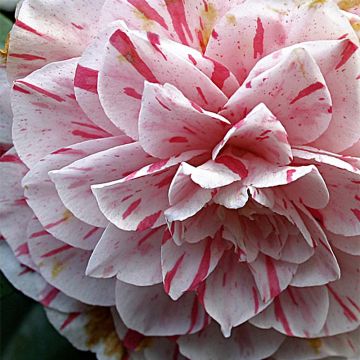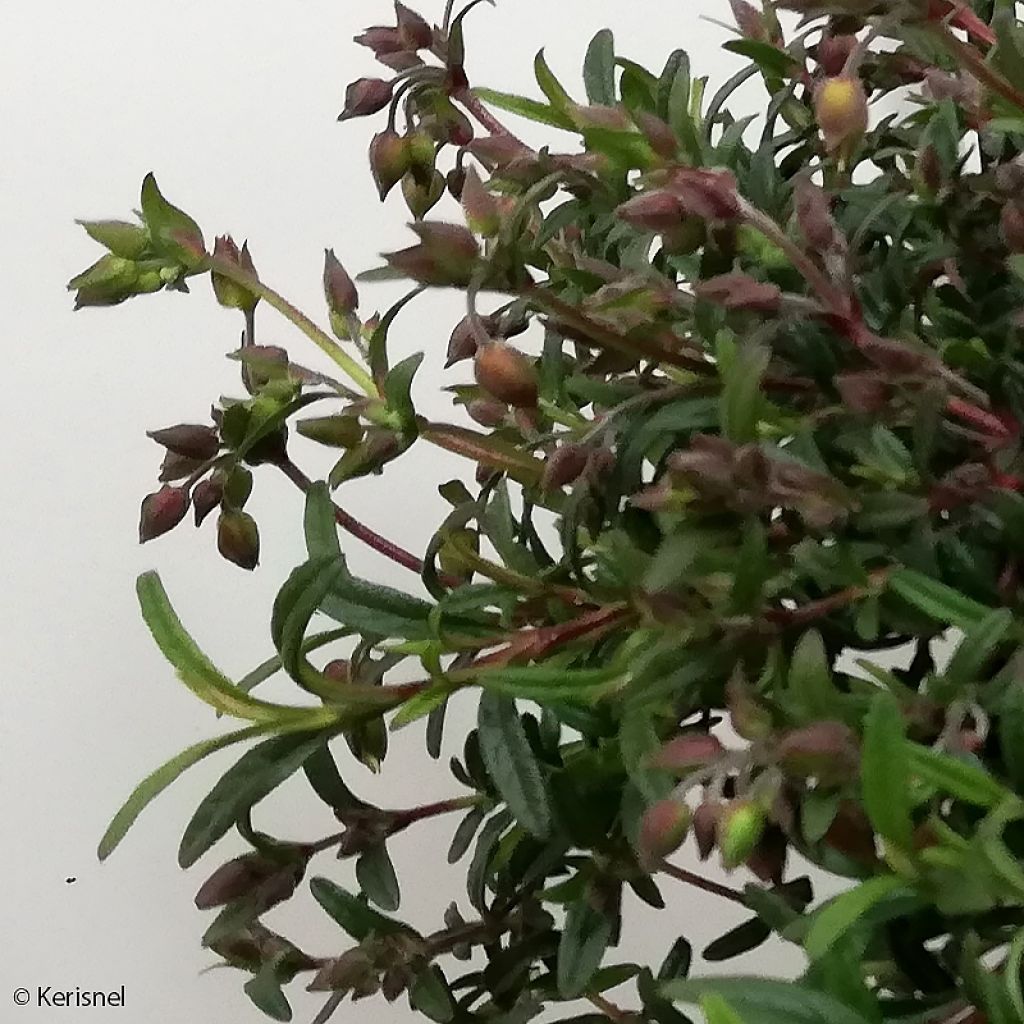

Halimiocistus sahucci - Halimiociste de Sahuc
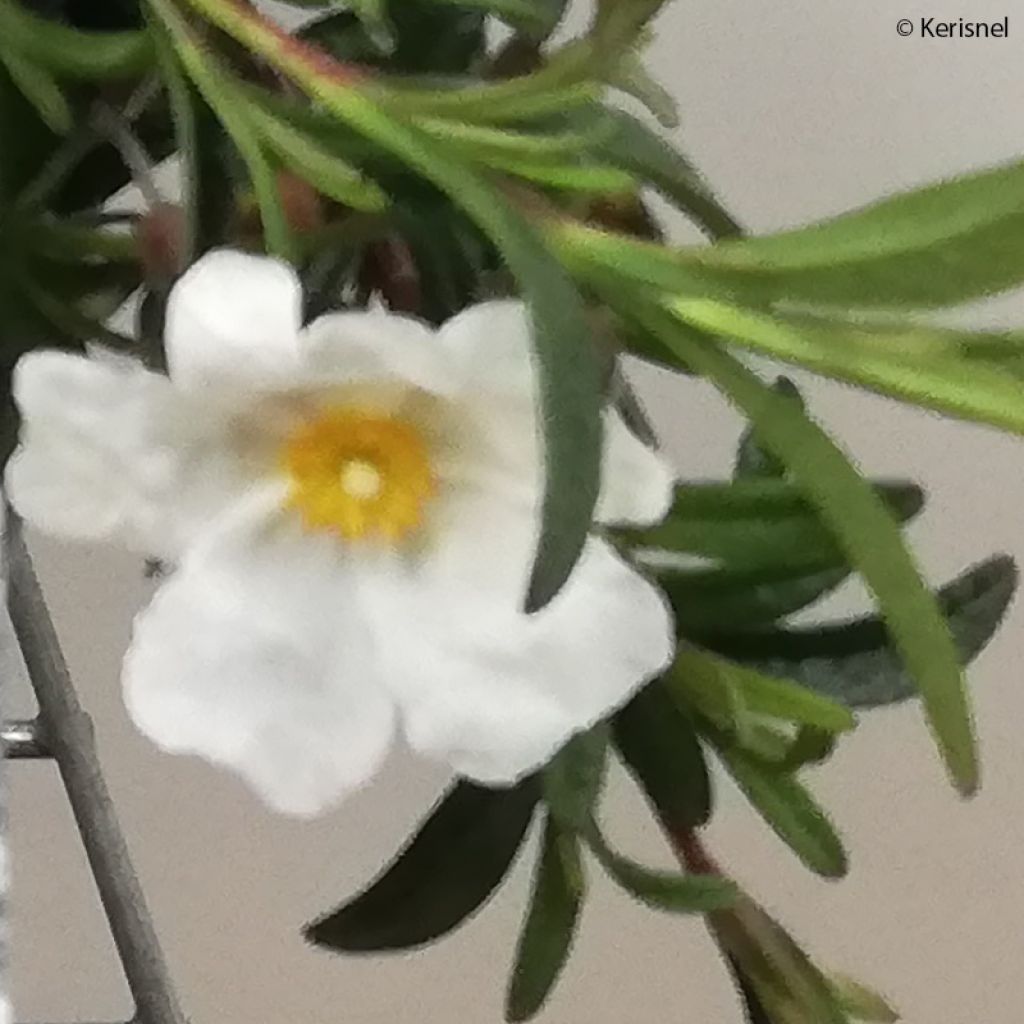

Halimiocistus sahucci - Halimiociste de Sahuc
Halimiocistus sahucii
(x) Halimiocistus sahucii
sahuc rock rose
This item cannot be shipped to the selected country
Delivery charge from €5.90
Delivery to Corse prohibited
More information
Schedule delivery date,
and select date in basket
This plant carries a 24 months recovery warranty
More information
We guarantee the quality of our plants for a full growing cycle, and will replace at our expense any plant that fails to recover under normal climatic and planting conditions.
From €5.90 for pickup delivery and €6.90 for home delivery
Express home delivery from €8.90.
Delivery to Corse prohibited: UE law prohibits the import of this plant from mainland France to Corse as part of the fight against Xylella fastidiosa. Please accept our sincere apologies.
More information
Does this plant fit my garden?
Set up your Plantfit profile →
Description
x Halimiocistus sahucii is a small bush resulting from spontaneous cross-breeding between Cistus salviifolius and Halimium umbellatus. The plant forms a low and wide dome and its thick foliage remains evergreen in winter. In spring, its growth is covered with a multitude of small white flowers with yellow centres, transforming it into a remarkably bright ball. Cistus plants not very resistant to severe frost. This attractive hybrid will make a great impression in rock gardens, on a dry slope, or mixed with other Mediterranean shrubs in a dry garden.
x Halimiocistus sahucii belongs to the Cistaceae family. Its first parent is the sage-leaved rock rose, which dots the dry slopes and woods of Mediterranean regions in Europe. The second parent is the rock-rose with umbels, specific to siliceous and rocky slopes. This branched, bushy shrub has a loose and spreading habit. It will reach about 50 cm (19.7 in) in height, with a diameter of 90 cm. Flowering occurs in spring or early summer depending on the climate (in May-June), and lasts for about three weeks. The flowers are round and fully open corollas, 3 cm (1.2 in) in diameter. They have 5 pure white petals surrounding a bright yellow centre. Each flower only lives for a day, covering the ground with its petals in the late afternoon, but it will already be replaced the next morning. The persistent foliage is composed of thick and wavy, oval, medium to dark green, hairy leaves, measuring 3 to 5 cm (1.2 to 2 in) in length. This variety can withstand short frosts of about -7°C (19.4 °F) once mature if planted in well-drained soil, sheltered from the wind.
x Halimiocistus sahucii is a plant for rock gardens and poor soils, well adapted to drought and coastal areas. Create a group, reminiscent of the garrigue, by mixing the foliage and scents of lavenders (blue, white, pink), rosemary (creeping or upright), thymes (T.vulgaris, T. polytrichus), salvias (Salvia x jamensis or officinalis), oreganos, teucriums (T.chamaedrys, T. x lucidrys, T. hircanicum), catmints, ballotes and dryland spurges (E.characias, E. cyparissias). The combination of this white cistus with the Mauritanian bindweed Convolvulus sabatius is sensational.
The rock rose is a pioneer plant, linked to fire ecology. In nature, seed germination is subject to the intense and brief heat associated with fires. These shrubs quickly colonize devastated surfaces, allowing other plants to settle in the shelter of their branches. With a relatively short lifespan of 10 to 15 years, cistus plants then make way for larger shrubs that deprive them of sunlight.
Report an error about the product description
Halimiocistus sahucii in pictures


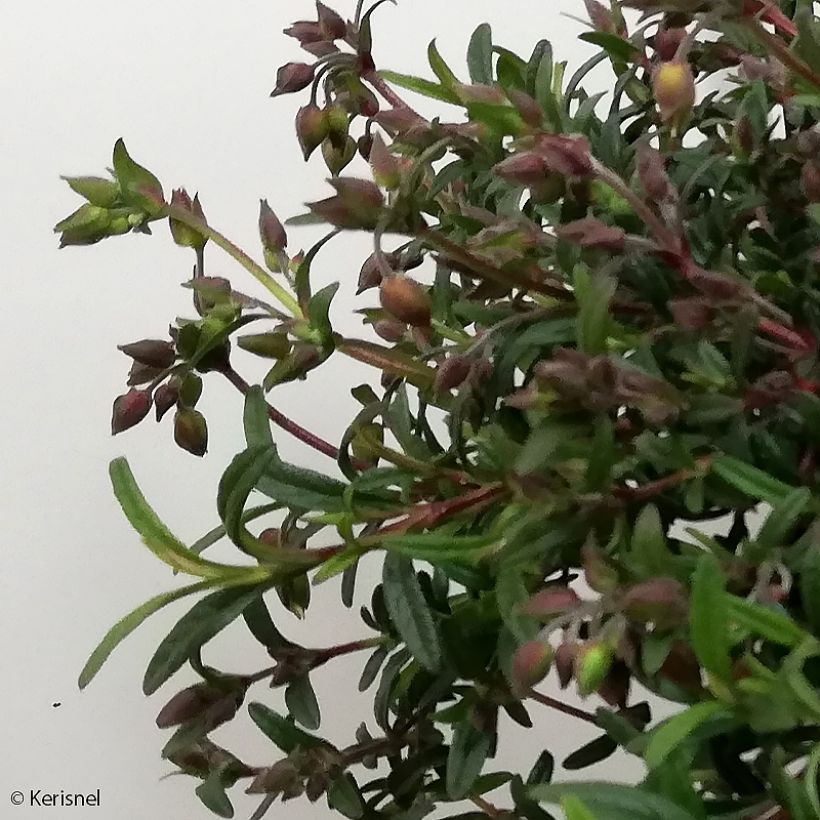

Plant habit
Flowering
Foliage
Botanical data
(x) Halimiocistus
sahucii
Cistaceae
sahuc rock rose
Cultivar or hybrid
Other Cistus - Rockrose
Planting and care
Sahuc's rock rose requires full sun (or at most partial shade in Mediterranean areas) and a perfectly drained, rocky or sandy, poor soil, whether it be acidic, neutral or even slightly chalky. This shrub is drought-resistant when well-established. Water abundantly during the first summer after planting, but spaced it out (11 litres of water per week). Afterwards, it will rely on rainwater, even in very dry regions. Under these conditions, it is hardy down to -7°C (19.4 °F) once mature and will live longer. Mulch it in winter in slightly colder regions and protect it from wind and cold as much as possible. Place it in the warmest corner of the garden, in full sun against a south-facing wall, in a rocky or sandy slope or any substrate that does not retain moisture, which would be fatal to it in winter or summer, which is its vegetative rest period. The combination of heat and humidity leads to the development of a fungus that attacks the plant's collar and would be fatal to it as much as a Siberian cold. You can lightly prune the stems after flowering to encourage the plant to branch out. Avoid severe pruning.
Planting period
Intended location
Care
This item has not been reviewed yet - be the first to leave a review about it.
Evergreen shrubs
Haven't found what you were looking for?
Hardiness is the lowest winter temperature a plant can endure without suffering serious damage or even dying. However, hardiness is affected by location (a sheltered area, such as a patio), protection (winter cover) and soil type (hardiness is improved by well-drained soil).

Photo Sharing Terms & Conditions
In order to encourage gardeners to interact and share their experiences, Promesse de fleurs offers various media enabling content to be uploaded onto its Site - in particular via the ‘Photo sharing’ module.
The User agrees to refrain from:
- Posting any content that is illegal, prejudicial, insulting, racist, inciteful to hatred, revisionist, contrary to public decency, that infringes on privacy or on the privacy rights of third parties, in particular the publicity rights of persons and goods, intellectual property rights, or the right to privacy.
- Submitting content on behalf of a third party;
- Impersonate the identity of a third party and/or publish any personal information about a third party;
In general, the User undertakes to refrain from any unethical behaviour.
All Content (in particular text, comments, files, images, photos, videos, creative works, etc.), which may be subject to property or intellectual property rights, image or other private rights, shall remain the property of the User, subject to the limited rights granted by the terms of the licence granted by Promesse de fleurs as stated below. Users are at liberty to publish or not to publish such Content on the Site, notably via the ‘Photo Sharing’ facility, and accept that this Content shall be made public and freely accessible, notably on the Internet.
Users further acknowledge, undertake to have ,and guarantee that they hold all necessary rights and permissions to publish such material on the Site, in particular with regard to the legislation in force pertaining to any privacy, property, intellectual property, image, or contractual rights, or rights of any other nature. By publishing such Content on the Site, Users acknowledge accepting full liability as publishers of the Content within the meaning of the law, and grant Promesse de fleurs, free of charge, an inclusive, worldwide licence for the said Content for the entire duration of its publication, including all reproduction, representation, up/downloading, displaying, performing, transmission, and storage rights.
Users also grant permission for their name to be linked to the Content and accept that this link may not always be made available.
By engaging in posting material, Users consent to their Content becoming automatically accessible on the Internet, in particular on other sites and/or blogs and/or web pages of the Promesse de fleurs site, including in particular social pages and the Promesse de fleurs catalogue.
Users may secure the removal of entrusted content free of charge by issuing a simple request via our contact form.
The flowering period indicated on our website applies to countries and regions located in USDA zone 8 (France, the United Kingdom, Ireland, the Netherlands, etc.)
It will vary according to where you live:
- In zones 9 to 10 (Italy, Spain, Greece, etc.), flowering will occur about 2 to 4 weeks earlier.
- In zones 6 to 7 (Germany, Poland, Slovenia, and lower mountainous regions), flowering will be delayed by 2 to 3 weeks.
- In zone 5 (Central Europe, Scandinavia), blooming will be delayed by 3 to 5 weeks.
In temperate climates, pruning of spring-flowering shrubs (forsythia, spireas, etc.) should be done just after flowering.
Pruning of summer-flowering shrubs (Indian Lilac, Perovskia, etc.) can be done in winter or spring.
In cold regions as well as with frost-sensitive plants, avoid pruning too early when severe frosts may still occur.
The planting period indicated on our website applies to countries and regions located in USDA zone 8 (France, United Kingdom, Ireland, Netherlands).
It will vary according to where you live:
- In Mediterranean zones (Marseille, Madrid, Milan, etc.), autumn and winter are the best planting periods.
- In continental zones (Strasbourg, Munich, Vienna, etc.), delay planting by 2 to 3 weeks in spring and bring it forward by 2 to 4 weeks in autumn.
- In mountainous regions (the Alps, Pyrenees, Carpathians, etc.), it is best to plant in late spring (May-June) or late summer (August-September).
The harvesting period indicated on our website applies to countries and regions in USDA zone 8 (France, England, Ireland, the Netherlands).
In colder areas (Scandinavia, Poland, Austria...) fruit and vegetable harvests are likely to be delayed by 3-4 weeks.
In warmer areas (Italy, Spain, Greece, etc.), harvesting will probably take place earlier, depending on weather conditions.
The sowing periods indicated on our website apply to countries and regions within USDA Zone 8 (France, UK, Ireland, Netherlands).
In colder areas (Scandinavia, Poland, Austria...), delay any outdoor sowing by 3-4 weeks, or sow under glass.
In warmer climes (Italy, Spain, Greece, etc.), bring outdoor sowing forward by a few weeks.

































